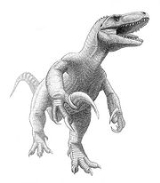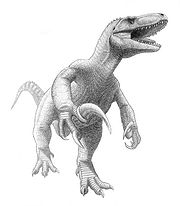
Portezuelo Formation
Encyclopedia
The Portezuelo Formation is a geologic formation
outcrop
ping in the Mendoza
, Río Negro
and Neuquén
provinces of Argentina
. It is the fourth-oldest formation in the Neuquén Group
and the older of the two formations in the Río Neuquén Subgroup. Formerly that subgroup was treated as a formation, and the Portezuelo Formation was known as the Portezuelo Member.
The type locality of the Portezuelo Formation is the mountain range
known as Sierra del Portezuelo in Neuquén province. This formation conformably
overlies the Lisandro Formation of the Río Limay Subgroup. In the top layers it grades into the Plottier Formation
, the younger formation within the Río Neuquén Subgroup.
Sandstone
s and siltstone
s, probably deposited under fluvial
conditions, make up the Portezuelo Formation. There are also occasional cemented claystone
deposits, as well as numerous paleosol
s (fossil soils). The formation varies between 95 and 130 meters thick throughout its range.

 Era: Mesozoic
Era: Mesozoic
Period: Late Cretaceous
Age: late Turonian
to early Coniacian
Absolute Age
: ~91 to ~88 mya
fossil
s have recently been described from this formation, as well as remains of several other types of animal
s:
Geologic formation
A formation or geological formation is the fundamental unit of lithostratigraphy. A formation consists of a certain number of rock strata that have a comparable lithology, facies or other similar properties...
outcrop
Outcrop
An outcrop is a visible exposure of bedrock or ancient superficial deposits on the surface of the Earth. -Features:Outcrops do not cover the majority of the Earth's land surface because in most places the bedrock or superficial deposits are covered by a mantle of soil and vegetation and cannot be...
ping in the Mendoza
Mendoza Province
The Province of Mendoza is a province of Argentina, located in the western central part of the country in the Cuyo region. It borders to the north with San Juan, the south with La Pampa and Neuquén, the east with San Luis, and to the west with the republic of Chile; the international limit is...
, Río Negro
Río Negro Province
Río Negro is a province of Argentina, located at the northern edge of Patagonia. Neighboring provinces are from the south clockwise Chubut, Neuquén, Mendoza, La Pampa and Buenos Aires. To the east lies the Atlantic Ocean.Its capital is Viedma...
and Neuquén
Neuquén Province
Neuquén is a province of Argentina, located in the west of the country, at the northern end of Patagonia. It borders Mendoza Province to the north, Rio Negro Province to the southeast, and Chile to the west...
provinces of Argentina
Argentina
Argentina , officially the Argentine Republic , is the second largest country in South America by land area, after Brazil. It is constituted as a federation of 23 provinces and an autonomous city, Buenos Aires...
. It is the fourth-oldest formation in the Neuquén Group
Neuquén Group
The Neuquén Group is a group of geologic formations found in Argentina. Rocks in the Neuquén Group fall within the Cenomanian to early Campanian stages of the Late Cretaceous Period, about 100 million to 80 million years in age...
and the older of the two formations in the Río Neuquén Subgroup. Formerly that subgroup was treated as a formation, and the Portezuelo Formation was known as the Portezuelo Member.
The type locality of the Portezuelo Formation is the mountain range
Mountain range
A mountain range is a single, large mass consisting of a succession of mountains or narrowly spaced mountain ridges, with or without peaks, closely related in position, direction, formation, and age; a component part of a mountain system or of a mountain chain...
known as Sierra del Portezuelo in Neuquén province. This formation conformably
Unconformity
An unconformity is a buried erosion surface separating two rock masses or strata of different ages, indicating that sediment deposition was not continuous. In general, the older layer was exposed to erosion for an interval of time before deposition of the younger, but the term is used to describe...
overlies the Lisandro Formation of the Río Limay Subgroup. In the top layers it grades into the Plottier Formation
Plottier Formation
The Plottier Formation is a geologic formation that outcrops in the Argentine Patagonian provinces of Río Negro and Neuquén. It is the younger of two formations belonging to the Río Neuquén Subgroup within the Neuquén Group, with the oldest rocks dating from the late Coniacian and its youngest...
, the younger formation within the Río Neuquén Subgroup.
Sandstone
Sandstone
Sandstone is a sedimentary rock composed mainly of sand-sized minerals or rock grains.Most sandstone is composed of quartz and/or feldspar because these are the most common minerals in the Earth's crust. Like sand, sandstone may be any colour, but the most common colours are tan, brown, yellow,...
s and siltstone
Siltstone
Siltstone is a sedimentary rock which has a grain size in the silt range, finer than sandstone and coarser than claystones.- Description :As its name implies, it is primarily composed of silt sized particles, defined as grains 1/16 - 1/256 mm or 4 to 8 on the Krumbein phi scale...
s, probably deposited under fluvial
Fluvial
Fluvial is used in geography and Earth science to refer to the processes associated with rivers and streams and the deposits and landforms created by them...
conditions, make up the Portezuelo Formation. There are also occasional cemented claystone
Claystone
Claystone is a geological term used to describe a clastic sedimentary rock that is composed primarily of clay-sized particles ....
deposits, as well as numerous paleosol
Paleosol
In the geosciences, paleosol can have two meanings. The first meaning, common in geology and paleontology, refers to a former soil preserved by burial underneath either sediments or volcanic deposits , which in the case of older deposits have lithified into rock...
s (fossil soils). The formation varies between 95 and 130 meters thick throughout its range.
Age


Mesozoic
The Mesozoic era is an interval of geological time from about 250 million years ago to about 65 million years ago. It is often referred to as the age of reptiles because reptiles, namely dinosaurs, were the dominant terrestrial and marine vertebrates of the time...
Period: Late Cretaceous
Cretaceous
The Cretaceous , derived from the Latin "creta" , usually abbreviated K for its German translation Kreide , is a geologic period and system from circa to million years ago. In the geologic timescale, the Cretaceous follows the Jurassic period and is followed by the Paleogene period of the...
Age: late Turonian
Turonian
The Turonian is, in the ICS' geologic timescale, the second age in the Late Cretaceous epoch, or a stage in the Upper Cretaceous series. It spans the time between 93.5 ± 0.8 Ma and 89.3 ± 1 Ma...
to early Coniacian
Coniacian
The Coniacian is an age or stage in the geologic timescale. It is a subdivision of the Late Cretaceous epoch or Upper Cretaceous series and spans the time between 89.3 ± 1 Ma and 85.8 ± 0.7 Ma...
Absolute Age
Geochronology
Geochronology is the science of determining the age of rocks, fossils, and sediments, within a certain degree of uncertainty inherent to the method used. A variety of dating methods are used by geologists to achieve this, and schemes of classification and terminology have been proposed...
: ~91 to ~88 mya
Paleontology
Many dinosaurDinosaur
Dinosaurs are a diverse group of animals of the clade and superorder Dinosauria. They were the dominant terrestrial vertebrates for over 160 million years, from the late Triassic period until the end of the Cretaceous , when the Cretaceous–Paleogene extinction event led to the extinction of...
fossil
Fossil
Fossils are the preserved remains or traces of animals , plants, and other organisms from the remote past...
s have recently been described from this formation, as well as remains of several other types of animal
Animal
Animals are a major group of multicellular, eukaryotic organisms of the kingdom Animalia or Metazoa. Their body plan eventually becomes fixed as they develop, although some undergo a process of metamorphosis later on in their life. Most animals are motile, meaning they can move spontaneously and...
s:
- abundant and diverse turtleTurtleTurtles are reptiles of the order Testudines , characterised by a special bony or cartilaginous shell developed from their ribs that acts as a shield...
s including Portezueloemys and a species of Prochelidella - rare crocodiliaCrocodiliaCrocodilia is an order of large reptiles that appeared about 84 million years ago in the late Cretaceous Period . They are the closest living relatives of birds, as the two groups are the only known survivors of the Archosauria...
ns - titanosaurian sauropods including MalarguesaurusMalarguesaurusMalarguesaurus is a genus of titanosauriform sauropod dinosaur from the Late Cretaceous of Mendoza Province, Argentina. Its fossils, consisting of tail vertebrae, chevrons, ribs, and limb bones, were found in the late Turonian-early Coniacian-age Portezuelo Formation of the Neuquén Group...
- dromaeosaurid theropods (NeuquenraptorNeuquenraptorNeuquenraptor is a dromaeosaurid theropod dinosaur of the Late Cretaceous of Argentina, one of the first dromaeosaurids found in the Southern Hemisphere....
, UnenlagiaUnenlagiaUnenlagia is a genus of, possibly dromaeosaurid, theropod dinosaur from the Late Cretaceous of Argentina....
) - a carnosauriaCarnosauriaCarnosauria is a group of large predatory dinosaurs that lived during the Jurassic and Cretaceous periods. While it originally contained a wide assortment of giant theropods that were not closely related, the group has since been defined to encompass only the allosaurs and their closest kin...
n theropod (MegaraptorMegaraptorMegaraptor is a genus of large theropod dinosaur that lived in the Coniacian stage of the Late Cretaceous. Its fossils have been discovered in the Patagonian region of Argentina...
) - an alvarezsaurid theropod (PatagonykusPatagonykusPatagonykus is a genus of theropod dinosaur from the Upper Cretaceous of Argentina. This alvarezsaur was discovered in exposures of the Portezuelo Member of the Rio Neuquen Formation in the Neuquen Province of Argentina...
) - several other theropods, including a modern, possibly galliformGalliformesGalliformes are an order of heavy-bodied ground-feeding domestic or game bird, containing turkey, grouse, chicken, New and Old World Quail, ptarmigan, partridge, pheasant, and the Cracidae. Common names are gamefowl or gamebirds, landfowl, gallinaceous birds or galliforms...
birdBirdBirds are feathered, winged, bipedal, endothermic , egg-laying, vertebrate animals. Around 10,000 living species and 188 families makes them the most speciose class of tetrapod vertebrates. They inhabit ecosystems across the globe, from the Arctic to the Antarctic. Extant birds range in size from... - ornithopodOrnithopodOrnithopods or members of the clade Ornithopoda are a group of ornithischian dinosaurs that started out as small, bipedal running grazers, and grew in size and numbers until they became one of the most successful groups of herbivores in the Cretaceous world, and dominated the North American...
s including MacrogryphosaurusMacrogryphosaurusMacrogryphosaurus is a genus of basal iguanodont dinosaur from the Turonian-early Coniacian age Upper Cretaceous Portezuelo Formation of Patagonia, Argentina. It was described by Jorge Calvo and colleagues, with M...

